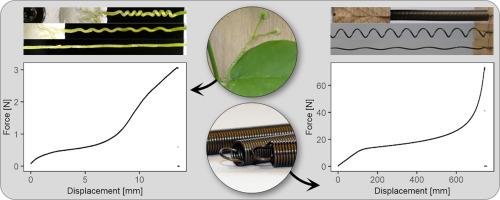Natural coil springs: Biomechanics and morphology of the coiled tendrils of the climbing passion flower Passiflora discophora
IF 9.4
1区 医学
Q1 ENGINEERING, BIOMEDICAL
引用次数: 0
Abstract
Tendrils of climbing plants possess a striking spring-like structure characterized by a minimum of two helices of opposite handedness connected by a perversion. By performing tensile experiments and morphological measurements on tendrils of the climbing passion flower Passiflora discophora, we show that these tendril springs act as coil springs within the plant's attachment system and resemble technical coil springs. However, tendril springs have a low spring index and a high pitch angle compared with typical metal coil springs resulting in a more complex loading situation in the plant tendrils. Moreover, the tendrils undergo a drastic shift from the fresh turgescent stage to a dried-off and dead senescent stage. This entails changes in material properties (elastic modulus in tension), morphology (tendril and helix diameter, number of windings), anatomy (tissue composition), and failure behavior (susceptibility to delamination) and reduces the degree of elasticity and strain at failure of the tendrils. Nevertheless, senescent tendrils remain functional as springs and maintain high energy dissipation capacity and high break force. This renders the system highly energy efficient, as the plant no longer needs to metabolically sustain the died-back tendrils. Because of its energy-storing spring system, its high energy dissipation and high safety factor, the attachment system can be considered a ‘fail-safe’ system.
Statement of significance
The use of coil springs as mechanical devices is not restricted to man-made machinery; striking spring structures can also be found within the attachment systems of climbing plants. Passiflora discophora climbs by using long thin tendrils with adhesive pads at their tips. Once the pads have attached to a support, the tendrils coil and form a spring-like structure. Here, we analyze the form and mechanics of these ‘tendril springs’, compare them with conventional technical coil springs, and discuss changes in the tendril springs during plant development. We reveal the main features of the attachment system, which might inspire new artificial attachment devices within the emerging field of plant-inspired soft-robotics.

天然螺旋弹簧:攀援西番莲卷须的生物力学和形态学。
攀援植物的卷须具有惊人的弹簧状结构,其特点是至少有两个手性相反的螺旋由一个反向连接。通过对攀援西番莲卷须进行拉伸实验和形态测量,我们发现这些卷须弹簧在植物附着系统中起着螺旋弹簧的作用,类似于技术螺旋弹簧。不过,与典型的金属螺旋弹簧相比,卷须弹簧的弹簧指数较低,俯仰角较大,因此植物卷须的负载情况更为复杂。此外,卷须还经历了从新鲜萌发阶段到干枯衰老阶段的急剧转变。这导致材料特性(拉伸弹性模量)、形态(卷须和螺旋直径、缠绕数量)、解剖结构(组织成分)和失效行为(分层敏感性)发生变化,并降低了卷须的弹性程度和失效时的应变。尽管如此,衰老卷须仍能保持弹簧的功能,并保持较高的能量耗散能力和较高的断裂力。这使得该系统具有很高的能效,因为植物不再需要通过新陈代谢来维持衰老卷须。由于具有储能弹簧系统、高耗能和高安全系数,该附着系统可被视为 "故障安全 "系统。意义说明: :螺旋弹簧作为机械装置的使用并不局限于人造机械,在攀援植物的附着系统中也能发现引人注目的弹簧结构。西番莲(Passiflora discophora)通过细长的卷须攀爬,卷须顶端带有粘垫。一旦胶垫附着在支撑物上,卷须就会盘绕起来,形成类似弹簧的结构。在这里,我们分析了这些 "卷须弹簧 "的形态和力学,将其与传统的技术螺旋弹簧进行了比较,并讨论了卷须弹簧在植物发育过程中的变化。我们揭示了附着系统的主要特征,这可能会在新兴的植物启发软机器人领域激发新的人工附着装置。
本文章由计算机程序翻译,如有差异,请以英文原文为准。
求助全文
约1分钟内获得全文
求助全文
来源期刊

Acta Biomaterialia
工程技术-材料科学:生物材料
CiteScore
16.80
自引率
3.10%
发文量
776
审稿时长
30 days
期刊介绍:
Acta Biomaterialia is a monthly peer-reviewed scientific journal published by Elsevier. The journal was established in January 2005. The editor-in-chief is W.R. Wagner (University of Pittsburgh). The journal covers research in biomaterials science, including the interrelationship of biomaterial structure and function from macroscale to nanoscale. Topical coverage includes biomedical and biocompatible materials.
 求助内容:
求助内容: 应助结果提醒方式:
应助结果提醒方式:


